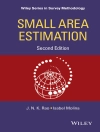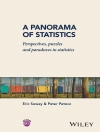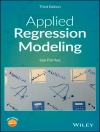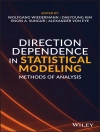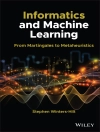Data Mining for Business Analytics: Concepts, Techniques, and Applications in R presents an applied approach to data mining concepts and methods, using R software for illustration
Readers will learn how to implement a variety of popular data mining algorithms in R (a free and open-source software) to tackle business problems and opportunities.
This is the fifth version of this successful text, and the first using R. It covers both statistical and machine learning algorithms for prediction, classification, visualization, dimension reduction, recommender systems, clustering, text mining and network analysis. It also includes:
* Two new co-authors, Inbal Yahav and Casey Lichtendahl, who bring both expertise teaching business analytics courses using R, and data mining consulting experience in business and government
* Updates and new material based on feedback from instructors teaching MBA, undergraduate, diploma and executive courses, and from their students
* More than a dozen case studies demonstrating applications for the data mining techniques described
* End-of-chapter exercises that help readers gauge and expand their comprehension and competency of the material presented
* A companion website with more than two dozen data sets, and instructor materials including exercise solutions, Power Point slides, and case solutions www.dataminingbook.com
Data Mining for Business Analytics: Concepts, Techniques, and Applications in R is an ideal textbook for graduate and upper-undergraduate level courses in data mining, predictive analytics, and business analytics. This new edition is also an excellent reference for analysts, researchers, and practitioners working with quantitative methods in the fields of business, finance, marketing, computer science, and information technology.
Jadual kandungan
Contents
Foreword by Gareth James xix
Foreword by Ravi Bapna xxi
Preface to the R Edition xxiii
Acknowledgments xxvii
PART I PRELIMINARIES
CHAPTER 1 Introduction 3
1.1 What Is Business Analytics? 3
1.2 What Is Data Mining? 5
1.3 Data Mining and Related Terms 5
1.4 Big Data 6
1.5 Data Science 7
1.6 Why Are There So Many Different Methods? 8
1.7 Terminology and Notation 9
1.8 Road Maps to This Book 11
Order of Topics 11
CHAPTER 2 Overview of the Data Mining Process 15
2.1 Introduction 15
2.2 Core Ideas in Data Mining 16
Classification 16
Prediction 16
Association Rules and Recommendation Systems 16
Predictive Analytics 17
Data Reduction and Dimension Reduction 17
Data Exploration and Visualization 17
Supervised and Unsupervised Learning 18
2.3 The Steps in Data Mining 19
2.4 Preliminary Steps 21
Organization of Datasets 21
Predicting Home Values in the West Roxbury Neighborhood 21
Loading and Looking at the Data in R 22
Sampling from a Database 24
Oversampling Rare Events in Classification Tasks 25
Preprocessing and Cleaning the Data 26
2.5 Predictive Power and Overfitting 33
Overfitting 33
Creation and Use of Data Partitions 35
2.6 Building a Predictive Model 38
Modeling Process 39
2.7 Using R for Data Mining on a Local Machine 43
2.8 Automating Data Mining Solutions 43
Data Mining Software: The State of the Market (by Herb Edelstein) 45
Problems 49
PART II DATA EXPLORATION AND DIMENSION REDUCTION
CHAPTER 3 Data Visualization 55
3.1 Uses of Data Visualization 55
Base R or ggplot? 57
3.2 Data Examples 57
Example 1: Boston Housing Data 57
Example 2: Ridership on Amtrak Trains 59
3.3 Basic Charts: Bar Charts, Line Graphs, and Scatter Plots 59
Distribution Plots: Boxplots and Histograms 61
Heatmaps: Visualizing Correlations and Missing Values 64
3.4 Multidimensional Visualization 67
Adding Variables: Color, Size, Shape, Multiple Panels, and Animation 67
Manipulations: Rescaling, Aggregation and Hierarchies, Zooming, Filtering 70
Reference: Trend Lines and Labels 74
Scaling up to Large Datasets 74
Multivariate Plot: Parallel Coordinates Plot 75
Interactive Visualization 77
3.5 Specialized Visualizations 80
Visualizing Networked Data 80
Visualizing Hierarchical Data: Treemaps 82
Visualizing Geographical Data: Map Charts 83
3.6 Summary: Major Visualizations and Operations, by Data Mining Goal 86
Prediction 86
Classification 86
Time Series Forecasting 86
Unsupervised Learning 87
Problems 88
CHAPTER 4 Dimension Reduction 91
4.1 Introduction 91
4.2 Curse of Dimensionality 92
4.3 Practical Considerations 92
Example 1: House Prices in Boston 93
4.4 Data Summaries 94
Summary Statistics 94
Aggregation and Pivot Tables 96
4.5 Correlation Analysis 97
4.6 Reducing the Number of Categories in Categorical Variables 99
4.7 Converting a Categorical Variable to a Numerical Variable 99
4.8 Principal Components Analysis 101
Example 2: Breakfast Cereals 101
Principal Components 106
Normalizing the Data 107
Using Principal Components for Classification and Prediction 109
4.9 Dimension Reduction Using Regression Models 111
4.10 Dimension Reduction Using Classification and Regression Trees 111
Problems 112
PART III PERFORMANCE EVALUATION
CHAPTER 5 Evaluating Predictive Performance 117
5.1 Introduction 117
5.2 Evaluating Predictive Performance 118
Naive Benchmark: The Average 118
Prediction Accuracy Measures 119
Comparing Training and Validation Performance 121
Lift Chart 121
5.3 Judging Classifier Performance 122
Benchmark: The Naive Rule 124
Class Separation 124
The Confusion (Classification) Matrix 124
Using the Validation Data 126
Accuracy Measures 126
Propensities and Cutoff for Classification 127
Performance in Case of Unequal Importance of Classes 131
Asymmetric Misclassification Costs 133
Generalization to More Than Two Classes 135
5.4 Judging Ranking Performance 136
Lift Charts for Binary Data 136
Decile Lift Charts 138
Beyond Two Classes 139
Lift Charts Incorporating Costs and Benefits 139
Lift as a Function of Cutoff 140
5.5 Oversampling 140
Oversampling the Training Set 144
Evaluating Model Performance Using a Non-oversampled Validation Set 144
Evaluating Model Performance if Only Oversampled Validation Set Exists 144
Problems 147
PART IV PREDICTION AND CLASSIFICATION METHODS
CHAPTER 6 Multiple Linear Regression 153
6.1 Introduction 153
6.2 Explanatory vs. Predictive Modeling 154
6.3 Estimating the Regression Equation and Prediction 156
Example: Predicting the Price of Used Toyota Corolla Cars 156
6.4 Variable Selection in Linear Regression 161
Reducing the Number of Predictors 161
How to Reduce the Number of Predictors 162
Problems 169
CHAPTER 7 k-Nearest Neighbors (k NN) 173
7.1 The k-NN Classifier (Categorical Outcome) 173
Determining Neighbors 173
Classification Rule 174
Example: Riding Mowers 175
Choosing k 176
Setting the Cutoff Value 179
k-NN with More Than Two Classes 180
Converting Categorical Variables to Binary Dummies 180
7.2 k-NN for a Numerical Outcome 180
7.3 Advantages and Shortcomings of k-NN Algorithms 182
Problems 184
CHAPTER 8 The Naive Bayes Classifier 187
8.1 Introduction 187
Cutoff Probability Method 188
Conditional Probability 188
Example 1: Predicting Fraudulent Financial Reporting 188
8.2 Applying the Full (Exact) Bayesian Classifier 189
Using the ‘Assign to the Most Probable Class’ Method 190
Using the Cutoff Probability Method 190
Practical Difficulty with the Complete (Exact) Bayes Procedure 190
Solution: Naive Bayes 191
The Naive Bayes Assumption of Conditional Independence 192
Using the Cutoff Probability Method 192
Example 2: Predicting Fraudulent Financial Reports, Two Predictors 193
Example 3: Predicting Delayed Flights 194
8.3 Advantages and Shortcomings of the Naive Bayes Classifier 199
Problems 202
CHAPTER 9 Classification and Regression Trees 205
9.1 Introduction 205
9.2 Classification Trees 207
Recursive Partitioning 207
Example 1: Riding Mowers 207
Measures of Impurity 210
Tree Structure 214
Classifying a New Record 214
9.3 Evaluating the Performance of a Classification Tree 215
Example 2: Acceptance of Personal Loan 215
9.4 Avoiding Overfitting 216
Stopping Tree Growth: Conditional Inference Trees 221
Pruning the Tree 222
Cross-Validation 222
Best-Pruned Tree 224
9.5 Classification Rules from Trees 226
9.6 Classification Trees for More Than Two Classes 227
9.7 Regression Trees 227
Prediction 228
Measuring Impurity 228
Evaluating Performance 229
9.8 Improving Prediction: Random Forests and Boosted Trees 229
Random Forests 229
Boosted Trees 231
9.9 Advantages and Weaknesses of a Tree 232
Problems 234
CHAPTER 10 Logistic Regression 237
10.1 Introduction 237
10.2 The Logistic Regression Model 239
10.3 Example: Acceptance of Personal Loan 240
Model with a Single Predictor 241
Estimating the Logistic Model from Data: Computing Parameter Estimates 243
Interpreting Results in Terms of Odds (for a Profiling Goal) 244
10.4 Evaluating Classification Performance 247
Variable Selection 248
10.5 Example of Complete Analysis: Predicting Delayed Flights 250
Data Preprocessing 251
Model-Fitting and Estimation 254
Model Interpretation 254
Model Performance 254
Variable Selection 257
10.6 Appendix: Logistic Regression for Profiling 259
Appendix A: Why Linear Regression Is Problematic for a Categorical Outcome 259
Appendix B: Evaluating Explanatory Power 261
Appendix C: Logistic Regression for More Than Two Classes 264
Problems 268
CHAPTER 11 Neural Nets 271
11.1 Introduction 271
11.2 Concept and Structure of a Neural Network 272
11.3 Fitting a Network to Data 273
Example 1: Tiny Dataset 273
Computing Output of Nodes 274
Preprocessing the Data 277
Training the Model 278
Example 2: Classifying Accident Severity 282
Avoiding Overfitting 283
Using the Output for Prediction and Classification 283
11.4 Required User Input 285
11.5 Exploring the Relationship Between Predictors and Outcome 287
11.6 Advantages and Weaknesses of Neural Networks 288
Problems 290
CHAPTER 12 Discriminant Analysis 293
12.1 Introduction 293
Example 1: Riding Mowers 294
Example 2: Personal Loan Acceptance 294
12.2 Distance of a Record from a Class 296
12.3 Fisher’s Linear Classification Functions 297
12.4 Classification Performance of Discriminant Analysis 300
12.5 Prior Probabilities 302
12.6 Unequal Misclassification Costs 302
12.7 Classifying More Than Two Classes 303
Example 3: Medical Dispatch to Accident Scenes 303
12.8 Advantages and Weaknesses 306
Problems 307
CHAPTER 13 Combining Methods: Ensembles and Uplift Modeling 311
13.1 Ensembles 311
Why Ensembles Can Improve Predictive Power 312
Simple Averaging 314
Bagging 315
Boosting 315
Bagging and Boosting in R 315
Advantages and Weaknesses of Ensembles 315
13.2 Uplift (Persuasion) Modeling 317
A-B Testing 318
Uplift 318
Gathering the Data 319
A Simple Model 320
Modeling Individual Uplift 321
Computing Uplift with R 322
Using the Results of an Uplift Model 322
13.3 Summary 324
Problems 325
PART V MINING RELATIONSHIPS AMONG RECORDS
CHAPTER 14 Association Rules and Collaborative Filtering 329
14.1 Association Rules 329
Discovering Association Rules in Transaction Databases 330
Example 1: Synthetic Data on Purchases of Phone Faceplates 330
Generating Candidate Rules 330
The Apriori Algorithm 333
Selecting Strong Rules 333
Data Format 335
The Process of Rule Selection 336
Interpreting the Results 337
Rules and Chance 339
Example 2: Rules for Similar Book Purchases 340
14.2 Collaborative Filtering 342
Data Type and Format 343
Example 3: Netflix Prize Contest 343
User-Based Collaborative Filtering: ‘People Like You’ 344
Item-Based Collaborative Filtering 347
Advantages and Weaknesses of Collaborative Filtering 348
Collaborative Filtering vs. Association Rules 349
14.3 Summary 351
Problems 352
CHAPTER 15 Cluster Analysis 357
15.1 Introduction 357
Example: Public Utilities 359
15.2 Measuring Distance Between Two Records 361
Euclidean Distance 361
Normalizing Numerical Measurements 362
Other Distance Measures for Numerical Data 362
Distance Measures for Categorical Data 365
Distance Measures for Mixed Data 366
15.3 Measuring Distance Between Two Clusters 366
Minimum Distance 366
Maximum Distance 366
Average Distance 367
Centroid Distance 367
15.4 Hierarchical (Agglomerative) Clustering 368
Single Linkage 369
Complete Linkage 370
Average Linkage 370
Centroid Linkage 370
Ward’s Method 370
Dendrograms: Displaying Clustering Process and Results 371
Validating Clusters 373
Limitations of Hierarchical Clustering 375
15.5 Non-Hierarchical Clustering: The k-Means Algorithm 376
Choosing the Number of Clusters (k) 377
Problems 382
PART VI FORECASTING TIME SERIES
CHAPTER 16 Handling Time Series 387
16.1 Introduction 387
16.2 Descriptive vs. Predictive Modeling 389
16.3 Popular Forecasting Methods in Business 389
Combining Methods 389
16.4 Time Series Components 390
Example: Ridership on Amtrak Trains 390
16.5 Data-Partitioning and Performance Evaluation 395
Benchmark Performance: Naive Forecasts 395
Generating Future Forecasts 396
Problems 398
CHAPTER 17 Regression-Based Forecasting 401
17.1 A Model with Trend 401
Linear Trend 401
Exponential Trend 405
Polynomial Trend 407
17.2 A Model with Seasonality 407
17.3 A Model with Trend and Seasonality 411
17.4 Autocorrelation and ARIMA Models 412
Computing Autocorrelation 413
Improving Forecasts by Integrating Autocorrelation Information 416
Evaluating Predictability 420
Problems 422
CHAPTER 18 Smoothing Methods 433
18.1 Introduction 433
18.2 Moving Average 434
Centered Moving Average for Visualization 434
Trailing Moving Average for Forecasting 435
Choosing Window Width (w) 439
18.3 Simple Exponential Smoothing 439
Choosing Smoothing Parameter 440
Relation Between Moving Average and Simple Exponential Smoothing 440
18.4 Advanced Exponential Smoothing 442
Series with a Trend 442
Series with a Trend and Seasonality 443
Series with Seasonality (No Trend) 443
Problems 446
PART VII DATA ANALYTICS
CHAPTER 19 Social Network Analytics 455
19.1 Introduction 455
19.2 Directed vs. Undirected Networks 457
19.3 Visualizing and Analyzing Networks 458
Graph Layout 458
Edge List 460
Adjacency Matrix 461
Using Network Data in Classification and Prediction 461
19.4 Social Data Metrics and Taxonomy 462
Node-Level Centrality Metrics 463
Egocentric Network 463
Network Metrics 465
19.5 Using Network Metrics in Prediction and Classification 467
Link Prediction 467
Entity Resolution 467
Collaborative Filtering 468
19.6 Collecting Social Network Data with R 471
19.7 Advantages and Disadvantages 474
Problems 476
CHAPTER 20 Text Mining 479
20.1 Introduction 479
20.2 The Tabular Representation of Text: Term-Document Matrix and ‘Bag-of-Words’ 480
20.3 Bag-of-Words vs. Meaning Extraction at Document Level 481
20.4 Preprocessing the Text 482
Tokenization 484
Text Reduction 485
Presence/Absence vs. Frequency 487
Term Frequency-Inverse Document Frequency (TF-IDF) 487
From Terms to Concepts: Latent Semantic Indexing 488
Extracting Meaning 489
20.5 Implementing Data Mining Methods 489
20.6 Example: Online Discussions on Autos and Electronics 490
Importing and Labeling the Records 490
Text Preprocessing in R 491
Producing a Concept Matrix 491
Fitting a Predictive Model 492
Prediction 492
20.7 Summary 494
Problems 495
PART VIII CASES
CHAPTER 21 Cases 499
21.1 Charles Book Club 499
The Book Industry 499
Database Marketing at Charles 500
Data Mining Techniques 502
Assignment 504
21.2 German Credit 505
Background 505
Data 506
Assignment 507
21.3 Tayko Software Cataloger 510
Background 510
The Mailing Experiment 510
Data 510
Assignment 512
21.4 Political Persuasion 513
Background 513
Predictive Analytics Arrives in US Politics 513
Political Targeting 514
Uplift 514
Data 515
Assignment 516
21.5 Taxi Cancellations 517
Business Situation 517
Assignment 517
21.6 Segmenting Consumers of Bath Soap 518
Business Situation 518
Key Problems 519
Data 519
Measuring Brand Loyalty 519
Assignment 521
21.7 Direct-Mail Fundraising 521
Background 521
Data 522
Assignment 523
21.8 Catalog Cross-Selling 524
Background 524
Assignment 524
21.9 Predicting Bankruptcy 525
Predicting Corporate Bankruptcy 525
Assignment 526
21.10 Time Series Case: Forecasting Public Transportation Demand 528
Background 528
Problem Description 528
Available Data 528
Assignment Goal 528
Assignment 529
Tips and Suggested Steps 529
References 531
Data Files Used in the Book 533
Index 535
Mengenai Pengarang
Galit Shmueli, Ph D, is Distinguished Professor at National Tsing Hua University’s Institute of Service Science. She has designed and instructed data mining courses since 2004 at University of Maryland, Statistics.com, Indian School of Business, and National Tsing Hua University, Taiwan. Professor Shmueli is known for her research and teaching in business analytics, with a focus on statistical and data mining methods in information systems and healthcare. She has authored over 70 publications including books.
Peter C. Bruce is President and Founder of the Institute for Statistics Education at Statistics.com. He has written multiple journal articles
and is the developer of Resampling Stats software. He is the author of Introductory Statistics and Analytics: A Resampling Perspective (Wiley) and co-author of Practical Statistics for Data Scientists: 50 Essential Concepts (O’Reilly).
Inbal Yahav, Ph D, is Professor at the Graduate School of Business Administration at Bar-Ilan University, Israel. She teaches courses in social network analysis, advanced research methods, and software quality assurance. Dr. Yahav received her Ph D in Operations Research and Data Mining from the University of Maryland, College Park.
Nitin R. Patel, Ph D, is Chairman and cofounder of Cytel, Inc., based in Cambridge, Massachusetts. A Fellow of the American Statistical Association, Dr. Patel has also served as a Visiting Professor at the Massachusetts Institute of Technology and at Harvard University. He is a Fellow of the Computer Society of India and was a professor at the Indian Institute of Management, Ahmedabad, for 15 years.
Kenneth C. Lichtendahl, Jr., Ph D, is Associate Professor at the University of Virginia. He is the Eleanor F. and Phillip G. Rust Professor of Business Administration and teaches MBA courses in decision analysis, data analysis and optimization, and managerial quantitative analysis. He also teaches executive education courses in strategic analysis and decision-making, and managing the corporate aviation function.






